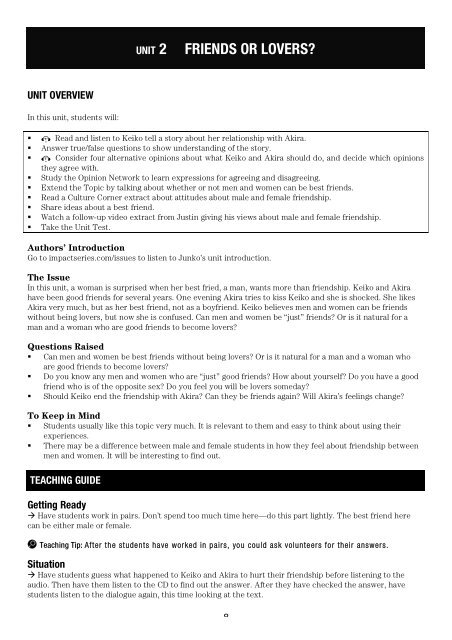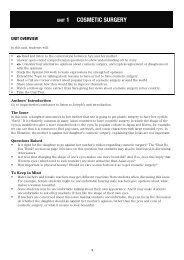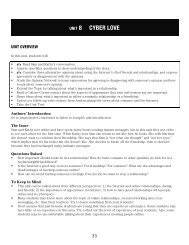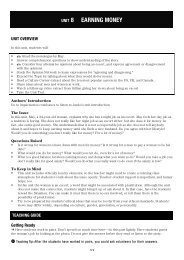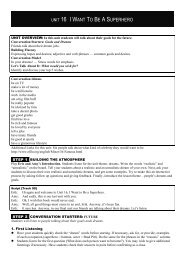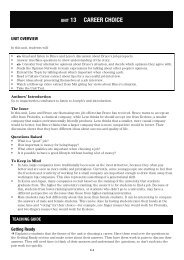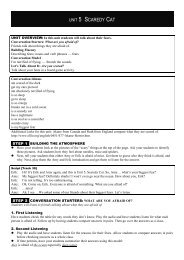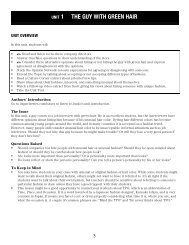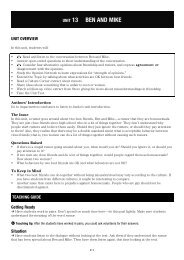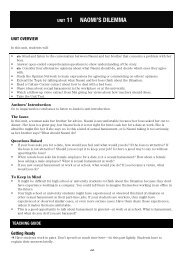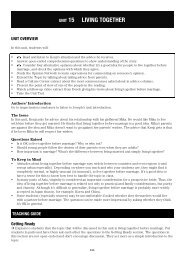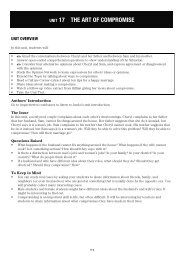UNIT 2 FRIENDS OR LOVERS? - Impact Series
UNIT 2 FRIENDS OR LOVERS? - Impact Series
UNIT 2 FRIENDS OR LOVERS? - Impact Series
You also want an ePaper? Increase the reach of your titles
YUMPU automatically turns print PDFs into web optimized ePapers that Google loves.
<strong>UNIT</strong> 2<br />
<strong>FRIENDS</strong> <strong>OR</strong> <strong>LOVERS</strong>?<br />
<strong>UNIT</strong> OVERVIEW<br />
In this unit, students will:<br />
<br />
<br />
<br />
<br />
<br />
<br />
<br />
<br />
<br />
T Read and listen to Keiko tell a story about her relationship with Akira.<br />
Answer true/false questions to show understanding of the story.<br />
T Consider four alternative opinions about what Keiko and Akira should do, and decide which opinions<br />
they agree with.<br />
Study the Opinion Network to learn expressions for agreeing and disagreeing.<br />
Extend the Topic by talking about whether or not men and women can be best friends.<br />
Read a Culture Corner extract about attitudes about male and female friendship.<br />
Share ideas about a best friend.<br />
Watch a follow-up video extract from Justin giving his views about male and female friendship.<br />
Take the Unit Test.<br />
Authors’ Introduction<br />
Go to impactseries.com/issues to listen to Junko’s unit introduction.<br />
The Issue<br />
In this unit, a woman is surprised when her best fried, a man, wants more than friendship. Keiko and Akira<br />
have been good friends for several years. One evening Akira tries to kiss Keiko and she is shocked. She likes<br />
Akira very much, but as her best friend, not as a boyfriend. Keiko believes men and women can be friends<br />
without being lovers, but now she is confused. Can men and women be “just” friends? Or is it natural for a<br />
man and a woman who are good friends to become lovers?<br />
Questions Raised<br />
Can men and women be best friends without being lovers? Or is it natural for a man and a woman who<br />
are good friends to become lovers?<br />
Do you know any men and women who are “just” good friends? How about yourself? Do you have a good<br />
friend who is of the opposite sex? Do you feel you will be lovers someday?<br />
Should Keiko end the friendship with Akira? Can they be friends again? Will Akira’s feelings change?<br />
To Keep in Mind<br />
Students usually like this topic very much. It is relevant to them and easy to think about using their<br />
experiences.<br />
There may be a difference between male and female students in how they feel about friendship between<br />
men and women. It will be interesting to find out.<br />
TEACHING GUIDE<br />
Getting Ready<br />
Have students work in pairs. Don’t spend too much time here—do this part lightly. The best friend here<br />
can be either male or female.<br />
m Teaching Tip: After the students have worked in pairs, you could ask volunteers for their answers.<br />
Situation<br />
Have students guess what happened to Keiko and Akira to hurt their friendship before listening to the<br />
audio. Then have them listen to the CD to find out the answer. After they have checked the answer, have<br />
students listen to the dialogue again, this time looking at the text.<br />
8
m Teaching Tip: Try a radio drama activity. Select two students or ask two volunteers to be radio drama<br />
players. They will read Keiko and Akira’s dialogue parts and Keiko’s monologue parts. Since it is a radio<br />
drama, they have to read the dialogue (and monologue) realistically; that is, Keiko is surprised, upset, and<br />
sad, and Akira is confused and angry. Make another pair and let them do the same thing. Class judges which<br />
group sounded more like a radio drama. (If you feel that Keiko’s part is too large, have another student to do<br />
Keiko’s monologue parts only.)<br />
Check Your Understanding<br />
Answer Key<br />
1. F 2. NI 3. F 4. NI 5.T<br />
What Do You Think?<br />
After you check students’ understanding of the story using the comprehension questions, students discuss<br />
the opinions of Iris, Mark, Shingo, and Anna. Have students do Activity A individually. Then have them move<br />
to Activity B and share their opinions in pairs.<br />
m Teaching Tip: The instruction says students can check all of the opinions they agree with, but they should<br />
realize the opinions are really different from each other.<br />
2 Culture Point: In the American movie When Harry Met Sally, with Billy Crystal and Meg Ryan, there is an<br />
interesting scene where Harry and Sally are in a car, Sally driving and Harry sitting next to her, discussing<br />
this issue of whether men and women can be friends. Harry says it never happens because men always want<br />
sex with the women they are friends with.<br />
Extending the Topic<br />
: Can they be best friends?<br />
Have students work individually when completing the chart, and in pairs (or threes) for the follow-up<br />
discussion.<br />
Give them enough time when completing the chart with reasons why men and women can or can’t be<br />
friends. The more they think about the reasons, the easier it will be for them to do the following<br />
discussion activity.<br />
Do the Extra Activity (role play) if there is time.<br />
Culture Corner<br />
Have students work in pairs or groups of three. Students read through the list of questions about male–female<br />
relationships. Give them an opportunity to ask about unknown words and expressions, such as crossed the<br />
line and entered your life. As an alternative, you can have students close their books as you read them the<br />
questions. Record the class’s answers on the board. (For example, in a class of 20 students, the tally for one<br />
question might be: yes = 11, no = 6, not sure = 3.) Then have students compare the class’s responses with the<br />
tallies in the textbook. The source for the answers was a survey in Psychology Today.<br />
Extra Activity: Role Play<br />
If there is time, consider doing the Extra Activity, a role play. Set up the role play by dividing the class into<br />
pairs. One member of each pair (student A) is Keiko. The other (student B) is Keiko’s friend. Student B<br />
listens to student A’s story and gives advice. (It’s OK for “Keiko” to be a male student.)<br />
Give the students a few minutes to prepare their role play. They can look over the Situation and the<br />
Extending the Topic activity, and write expressions they may want to use in their role play. Give the students<br />
about two minutes to act out their role play. Then you can ask for volunteer pairs to act out their role play in<br />
front of the class. Or you can put the students in groups of four and have each pair act out their role play for<br />
the other pair.<br />
Note: During role plays, students will make many grammatical errors. It’s usually best to comment first on<br />
their communication strategies: How effective were they at emphasizing their main points? In this instance,<br />
was “Keiko” clear in communicating the Situation and her need for advice? Was “the friend” supportive and<br />
clear in offering helpful advice?<br />
9
Sharing My Ideas: My best friends<br />
Choose<br />
Begin by having the students choose a topic. Explain that they are going to give a presentation about their<br />
current best friend or a best friend from their childhood.<br />
Prepare and Rehearse<br />
Be sure that students understand the adjectives in the Language Hints box and elicit more to add to the list.<br />
Write them on the board. Have students answer the questions in the Prepare box, and remind them to keep<br />
their notes simple. Encourage them to imagine their friend and to remember as many details about him or her<br />
as possible.<br />
When they are ready to rehearse, students first practice silently and then a second time with a partner. Point<br />
out the Listener task and go over the Presentation Tip. Have students work on their pace when they are<br />
rehearsing. You could demonstrate different paces by giving the sample presentation below too fast, too slow,<br />
and then at an appropriate pace.<br />
Sample Presentation<br />
My best friend is Yoshiko. We were classmates in high school and we have been friends since then. She is a<br />
unique person. She is friendly to anybody, and she makes friends with anybody. If her friend introduces<br />
another friend to her, they are friends immediately! I think that is her talent. She is also full of curiosity. When<br />
there is an interesting or unique exhibition, she never misses it. She does not miss interesting movies, either.<br />
She often invites me to go with her, and I get chances to see interesting art, movies, or shows. Because of her,<br />
my life is fun and rich! I think I have a really good friend.<br />
Present<br />
Have students work with a new partner or put them in small groups. Encourage listeners to take notes and<br />
remind them of the Listener task, which asks them to focus on the reason(s) the speaker gives for having that<br />
person as a best friend.<br />
If you are using the assessment guide below, go over each point with the whole class before students begin<br />
their presentations. (This could also be done during the Rehearse step so that students have time to prepare<br />
for or practice each assessment point.) Be sure to remind your students that communicating their ideas is<br />
more important than trying to use perfect English!<br />
Assessing the Activity<br />
Create a handout with a rating grid such as the one below, or simply write it on the board. (Note: For more<br />
information on student assessment and ways to modify the assessment system, see Assessing the Activity,<br />
Unit 1.)<br />
1 – The presenter’s voice was clear. ✮ ✮ ✮ ✮ ✮<br />
2 – The presenter spoke at a good pace—not too fast or too slowly. ✮ ✮ ✮ ✮ ✮<br />
3 – The presenter used adjectives to describe his or her friend. ✮ ✮ ✮ ✮ ✮<br />
4 – The presenter gave reasons for why this person was/is his or her best friend. ✮ ✮ ✮ ✮ ✮<br />
5 – The presentation was easy to understand . ✮ ✮ ✮ ✮ ✮<br />
When students are working in pairs, have each student evaluate the other. If a student presents in front of a<br />
small group or in front of the class, have each student evaluate him or her. A rater can give up to 5 stars for<br />
each category, so the maximum score for any presentation is 25 stars.<br />
Of course, you can also give your own assessment, along with positive suggestions for how the presenter can<br />
improve next time.<br />
10
PERSONAL OPINION<br />
If you have downloaded the video clip or have access to the Internet in class, play the video clip. The first<br />
time, have the students watch with books closed. Ask questions to see if the students have understood the<br />
gist of Justin’s opinion. Then have them look at the summary. See if they can fill in the missing words. Play<br />
the extract once or twice more. Then check the answers.<br />
Answer Key<br />
Justin<br />
This is an important topic in terms of modern relationships. In my view, men have to stop treating women as<br />
objects. They need to stop treating women as pretty girls, as decoration. In this case, I think Keiko is right to<br />
be shocked and upset. And I think Akira should be ashamed of himself. He should write a letter of apology to<br />
Keiko.<br />
Maybe he should even invite all their mutual friends together and publicly stand up and say, “I’m sorry, Keiko,<br />
for treating you as a sex object.” Good idea, don’t you think? Personally, I’d like Keiko and all of her friends<br />
and indeed all young women to stand up for their right to self-respect, and indeed their right to be friends and<br />
not only lovers with men.<br />
Video Script<br />
Well, I’m very glad to have an opportunity to talk about this ’cause it’s something I feel very strongly about.<br />
Men have to stop treating women as objects. They have to stop treating women as, ah, pretty dolls, as, ah, as<br />
decoration. I think Keiko is right to be shocked and upset and hurt. And I think Akira should be ashamed of<br />
himself. He should write a letter of apology to Keiko. He should write several emails of apology. He should<br />
make a video of apology. He should perhaps, ah, invite all their friends together and publicly stand up and say,<br />
“I’m sorry, ah, Keiko for treating you as a sexual object.” I’d like Keiko and all her friends and indeed all young<br />
women to stand up to their right to self-respect, and indeed their right to be friends.<br />
<strong>UNIT</strong> TEST<br />
Make copies of the Unit Test for each student. Distribute the copies and allow about 15 minutes for the<br />
class to complete the test. Correct the test in class.<br />
A. Understanding the Situation: The focus is on understanding Keiko and Akira’s relationship and why Akira<br />
is upset with Keiko.<br />
B. Vocabulary: The focus is on words or phrases from the Situation or the Extending the Topic sections.<br />
Students match three words with their definitions.<br />
C. Expressions: The focus is on checking students’ understanding of the What Do You Think? and Opinion<br />
Network sections.<br />
Answer Key<br />
A. 1. c 2. a 3. b 4. d 5. a B. 1. c 2. a 3. b C. 1. a 2. b<br />
LINKS<br />
If you would like the class to do additional research on friendship between men and women, here are some<br />
useful links:<br />
Can a man and a woman really be just friends?<br />
http://www.marieclaire.com/life/sex/advice/man-woman-friends<br />
Can a man and a woman be just friends? Nothing confuses friendship as much as sex—Sister Speak:<br />
http://findarticles.com/p/articles/mi_m1077/is_12_58/ai_109180661<br />
Just friendship between men and women: myth or reality?<br />
http://www.jurgita.com/articles-id925.html<br />
11


